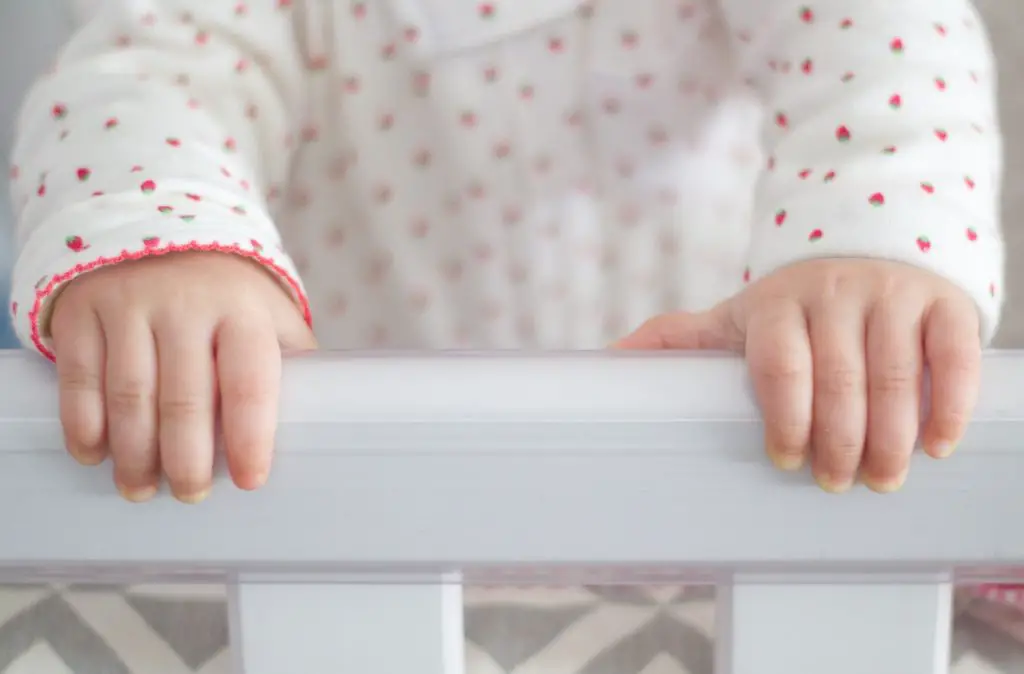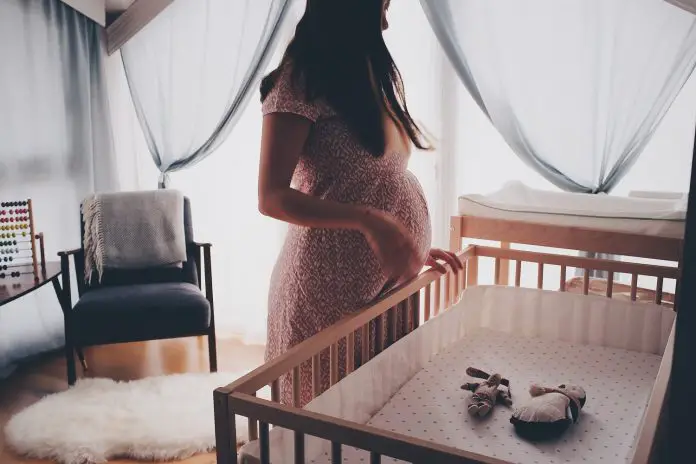Are you concerned if adding a rail cover to your crib will offer extra protection for your baby or if crib rail covers are safe? We asked parents for their top questions and our guide explains what to look out for and helps you assess if this is a good addition for your baby’s crib.
What is a crib rail cover?
A crib rail cover is a soft, padded cover that is placed over the top and sides of the crib to create a safe and comfortable environment for the baby while they sleep (read our guide on getting your baby to sleep in a crib). These covers can help to reduce the risk of baby’s getting their arms and legs stuck in the gap between the mattress and the crib rail, and can help to protect the crib rails from wear and tear. They are also a great way to add a bit of style and color to the nursery. You can also fit plastic rail covers that help protect the top of the crib’s wooden rail.
Are there any health or safety concerns associated with using crib rail covers?
In general, crib rail covers are completely safe but you should be aware that there are some health and safety concerns associated with using tie-on versions but if they are used correctly these risks are normally very low.
While these covers provide an extra layer of protection and help to reduce the risk of a baby’s head getting stuck between the bars of the crib, you should take care installing them. It is important to ensure that the crib rail cover fits securely and securely tied or fastened the crib. If the crib rail cover is too loose, it may pose a suffocation hazard. Additionally, any tears or rips in the material should be repaired or the crib rail cover should be replaced. It is also important to make sure the material of the crib rail cover is flame-resistant and free from hazardous chemicals such as lead and phthalates.

Are crib rail covers flame retardant?
When choosing a crib rail cover you must make sure you check that it’s designed to be flame retardant. The material used to make crib rail covers is usually fire-resistant, as it is designed to protect your baby from potential fires. The fabric used for crib rail covers is typically treated with a flame retardant chemical to prevent the spread of fire.
Some crib rail covers are also made using non-flammable materials, such as cotton, wool, or polyester. It is important to check the label of your crib rail cover to verify that it is flame retardant. Additionally, it is also important to keep your crib away from any open flames or heat sources. With proper care, your crib rail cover can provide an effective layer of protection from flame and heat.
Are rail covers waterproof?
Rail covers are not necessarily waterproof, but some can be treated or made with a waterproof material. Generally, crib rail covers are made from fabrics like cotton, flannel, or fleece which are not waterproof. However, some manufacturers offer waterproof crib rail covers that are made from a vinyl material.
These covers are designed to protect the crib rails from moisture and can be wiped down easily. It is important to check the product description to ensure that the cover is waterproof before purchasing. It is also important to follow the manufacturer’s instructions for care and cleaning.
Are crib rail covers made of organic, hypoallergenic materials?
Many crib rail covers are made of organic, hypoallergenic materials. Organic materials such as cotton, bamboo, and hemp are often used to make crib rail covers. These materials are free from hazardous chemicals, such as lead and phthalates, and are considered to be safe for babies and children. Additionally, organic materials are soft and gentle against baby’s skin, making them comfortable and non-irritating. Most reputable manufacturers of crib rail covers use safe and non-toxic materials that are free from these potentially harmful chemicals.
Hypoallergenic materials are often used in crib rail covers to prevent allergies and reduce the risk of skin irritation. Additionally, some crib rail covers are made of natural latex, which is a breathable, non-irritating material.
Look for materials that are organic and hypoallergenic, providing an extra layer of protection for your baby. Furthermore, many of these products are also tested and certified by third-party organizations to ensure that they meet the highest safety standards.
Are the covers machine washable?
Rail covers are usually machine washable. Most covers are made of cotton, polyester, or other fabrics that are safe to put in a washing machine. Most crib rail covers come with washing instructions, so it’s important to follow the manufacturer’s instructions for best results.
Generally, it’s best to wash crib rail covers on a gentle cycle with cold water and a mild detergent. It’s also a good idea to hang the covers to dry or tumble dry on low heat to avoid shrinkage. Following these steps should ensure that your crib rail covers remain machine washable for many years.
Can crib rail covers be easily removed and replaced?
Yes, they can be easily removed and replaced. They are designed with a simple tie or strap closure system which allows them to be quickly and easily attached to the crib. All you need to do is drape the cover over the rail, then tie the straps or ties to secure it in place. When you want to remove the cover, simply untie the straps or ties and slide the cover off the rail.
Crib rail covers are also lightweight and portable, making them easy to transport and store when not in use. With proper care and maintenance, crib rail covers can last for many years, providing a safe and comfortable environment for your baby.
Are the ties or straps of the crib rail cover secure and long enough to fit most cribs?
You need to be careful to make sure the ties or straps of your rail cover are both secure and long enough to fit your crib. The ties are usually adjustable, so they can be tightened or loosened to fit your specific crib. The straps are typically made of strong, durable materials that won’t tear or break, and the length of the straps is usually adequate to fit most cribs. Additionally, some crib rail covers come with extra ties or straps, just in case you need to replace them.
Is the fabric of a rail cover soft and comfortable?
Make sure the fabric is soft and comfortable! It is typically made of 100% cotton, which is gentle against baby’s skin and breathable. The fabric is also lightweight and stretchable, so it fits snugly around the crib rail to provide a secure fit. Additionally, the fabric is designed to be durable and long-lasting, so it can withstand the wear and tear of frequent washings. Furthermore, the fabric is designed to be hypoallergenic and free from hazardous chemicals, so it is safe for baby’s sensitive skin.
Are covers available in a variety of colors and patterns?
Yes, crib rail covers are available in a variety of colors and patterns. You can find crib rail covers that match any nursery theme or color scheme. They come in solid colors, stripes, prints, and even custom designs. Covers are a great way to add a touch of style and comfort to your nursery. They come in an array of textures, from soft cotton and flannel to waterproof vinyl and minky. Covers are also available in different sizes, so you can find one to fit any standard or custom-sized crib. With so many choices, you’re sure to find the perfect crib rail cover to suit your baby’s nursery.
Summary
We’ve asked parents for their main questions and concerns about crib rail covers and have provided comprehensive answers to help you make the right choice – and provide a safe and secure environment for your baby.


